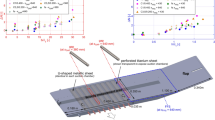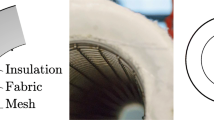Abstract
The objective of the work was to investigate the effect of compliant surfaces on the receptivity and bypass transition of a boundary layer. Hot wire measurements in the pre-transitional and transitional boundary layers on nine different compliant and one rigid surface with identical geometries were made. The experiments were conducted in air and the compliant surfaces were manufactured from gelatine covered by a 10 μm protective PVC film. The laminar boundary layer profiles and growth rate results were the same for all the surfaces. However, the receptivity of the laminar boundary layer to freestream disturbances increased close to the leading edge of each compliant surface. Further downstream the majority of the compliant surfaces were successful in reducing the receptivity to a value below that for the rigid surface. The transition onset position on the compliant surfaces ranged from 3% downstream to 20% upstream of the rigid surface position. It was concluded that compliant surfaces with optimum properties can reduce receptivity and delay transition.









Similar content being viewed by others
Abbreviations
- A m :
-
contact area between test mass and compliant surface
- c :
-
correction factor in measurement of compliant surface properties
- E :
-
Young’s modulus for compliant surface
- E d :
-
Young’s modulus from dynamic measurement
- E s :
-
Young’s modulus from static measurement
- g :
-
gravitational acceleration
- GainNW :
-
near wall gain
- L :
-
thickness of compliant surface
- m :
-
test mass
- Re x :
-
Reynolds number based on U and x
- Re xs :
-
Re x at start of transition
- Re θ :
-
Reynolds number based on U and θ
- t :
-
time
- Tu:
-
freestream turbulence level
- u :
-
air velocity
- u rms :
-
rms fluctuating air velocity
- U :
-
freestream air velocity
- U rms :
-
rms fluctuating freestream velocity
- x :
-
streamwise distance
- y :
-
wall normal distance
- z(t) :
-
displacement of compliant surface
- z i :
-
displacement amplitude of the ith cycle
- z 0 :
-
maximum displacement amplitude
- Δz :
-
deformation of compliant surface
- δ :
-
boundary layer thickness
- φ :
-
initial phase angle
- Γ :
-
system damping factor
- λ :
-
Pohlhausen pressure gradient parameter
- λ s :
-
turbulence length scale
- ν :
-
kinematic viscosity
- θ :
-
boundary layer momentum thickness
- ρ :
-
density of air
- ρ cs :
-
density of compliant surface
- ω n :
-
natural frequency of compliant surface/mass system
- ω d :
-
damped frequency
- ζ :
-
damping coefficient for compliant surface material
References
Brandt L, Schlatter P, Henningson DS (2004) Transition in boundary layers subject to free-stream turbulence. J Fluid Mech 517:167–198
Carpenter PW (1993) The optimization of multiple-panel compliant walls for delay of laminar-turbulence transition. AIAA J 31:1187–1188
Carpenter PW, Garrard AD (1985) The hydrodynamic stability of flows over Kramer-type compliant surface. Pt.1. Tollmien–Schlichting instabilities. J Fluid Mech 155:465–510
Choi KS, Yang X, Clayton BR, Glover EJ, Atlar M, Semenov BN, Kulik VM (1997) Turbulent drag reduction using compliant surfaces. Proc R Soc Lond 453:2229–2240
Davies C, Carpenter PW (1997) Numerical simulation of the evolution of Tollmien–Schlichting waves over finite compliant panels. J Fluid Mech 335:361–392
Dhawan S, Narasimha R (1957) Some properties of boundary layer flow during the transition from laminar to turbulent motion. J Fluid Mech 3:418–436
Ercan AH (1997) Experimental analysis and modelling of boundary layer transition. PhD thesis, Department of Engineering, University of Liverpool, Liverpool
Fransson JHM, Matsubara M, Alfredsson PH (2005) Transition induced by free-stream turbulence. J Fluid Mech 527:1–25
Fransson JHM, Talamelli A, Brandt L, Cusso C (2006) Delaying transition to turbulence by a passive mechanism. Phys Rev lett 96(6)
Gad-el-Hak M (1998) Compliant surfaces: the simpler alternative.” Exp Therm Fluid Sci 16(1–2):141–156
Gad-el-Hak M, Blackwelder RF, Riley JJ (1984) On the interaction of compliant coatings with boundary-layer flows. J Fluid Mech 140:257–280
Hansen RJ, Hunston DL, Ni CC, Reischman MM, Hoyt JW (1980) An experimental study of flow-generated waves on a flexible surface. J Sound Vibration 68:317–334
Johnson MW, Ercan AH (1999) A physical model for bypass transition. Int J Heat Fluid Fl 20(2):95–104
Johnson MW, Fasihfar A (1994) Statistical properties of turbulent bursts in transitional boundary layers. Int J Heat Fluid Fl 15(4):283–290
Mayle RE (1991) The role of laminar-turbulent transition in gas turbine engines. J Turbomach 113:509–537
Morkovin MV (1969) On the many faces of transition. In: Wells CS (ed) Viscous drag reduction. Plenum, New York
Roach PE (1987) The generation of nearly isotropic turbulence by means of grids. Int J Heat Fluid Flow 8(22):82–92
Yeo KS (1986) The stability of flow over flexible surfaces. PhD. thesis, University of Cambridge, Cambridge
Author information
Authors and Affiliations
Corresponding author
Appendix: dimensional analysis
Appendix: dimensional analysis
The transition process for a boundary layer is governed by the receptivity. For bypass transition the receptivity can be characterised by the near wall gain. For a zero pressure gradient boundary layer on a rigid surface, this will depend on the fluid density ρ, the fluid viscosity μ, the flow velocity U, the length scale of the freestream turbulence λ s and the boundary layer thickness δ. This leads to the dimensionless equation
When the rigid surface is replaced by a compliant one, the properties of the compliant surface must also be included. These are the density ρ cs, the Young’s modulus E, the damping coefficient ζ and the thickness of the layer L. A further four dimensionless quantities are then formed such that
where \( \frac{{\zeta ^{2} }} {{E\rho _{{{\text{cs}}}} L^{2} }} \) characterises the density, elastic and damping properties of the compliant surface and is used for this purpose in the current paper. The remaining three quantities compare the density, characteristic lengths and stresses, respectively for the compliant surface and fluid.
Rights and permissions
About this article
Cite this article
Huang, JC., Johnson, M.W. The influence of compliant surfaces on bypass transition. Exp Fluids 42, 711–718 (2007). https://doi.org/10.1007/s00348-007-0278-2
Received:
Revised:
Accepted:
Published:
Issue Date:
DOI: https://doi.org/10.1007/s00348-007-0278-2




